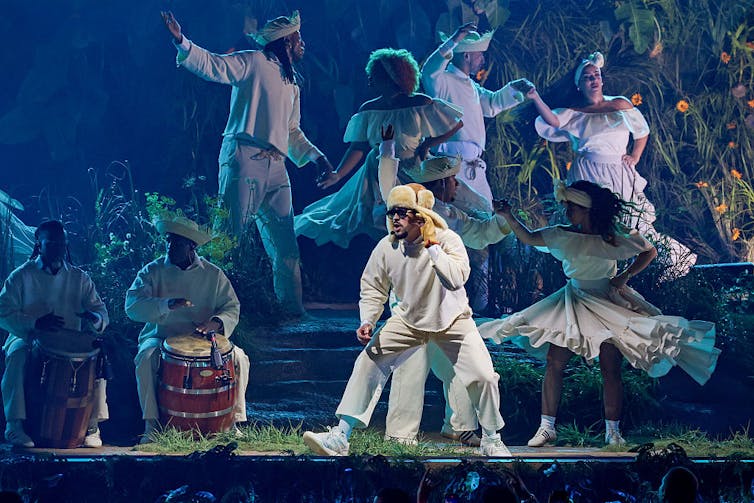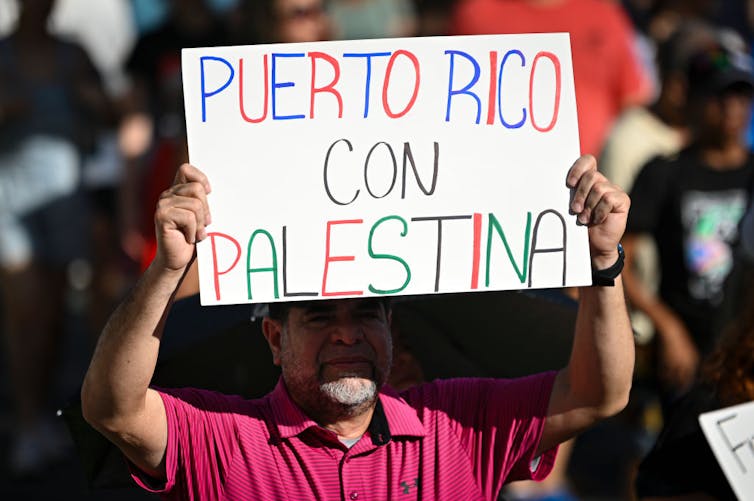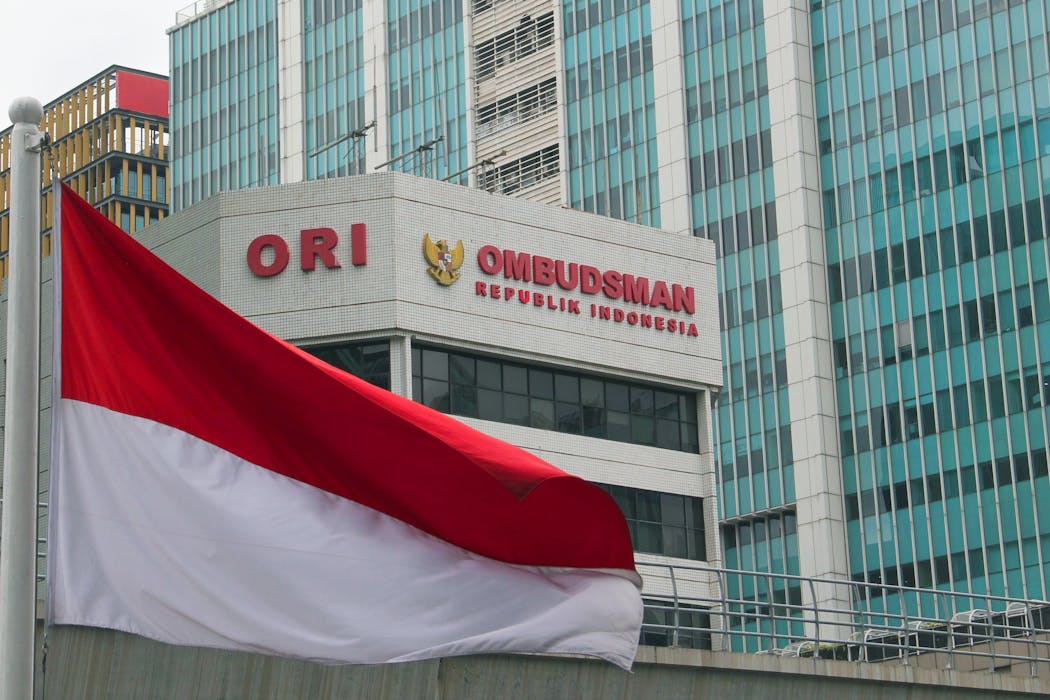Bad Bunny and Puerto Rican Muslims: How both remix what it means to be Boricua
- Written by Ken Chitwood, Affiliate Researcher, Religion and Civic Culture Center, USC Dornsife College of Letters, Arts and Sciences; Bayreuth University
Bad Bunny, born Benito Antonio Martínez Ocasio, is more than a global music phenomenon; he’s a bona fide symbol of Puerto Rico[1].
The church choir boy[2] turned “King of Latin Trap” has songs, style and swagger that reflect the island’s mix of pride, pain and creative resilience[3]. His music mixes reggaetón beats with the sounds of Puerto Rican history and everyday life, where devotion and defiance often live side by side.
Bad Bunny has been called one of Puerto Rico’s “loudest and proudest voices[4].” Songs like “El Apagón[5]” – “The Blackout” – celebrate joy and protest together, honoring everyday acts of resistance to colonial rule[6] and injustice in Puerto Rican life. Others, like “NUEVAYoL[7],” celebrate the sounds and vibrancy of its diaspora – especially in New York City[8]. Some songs, like “RLNDT,” mention spiritual searching[9] – featuring allusions to his own Catholic upbringing, sacred and secular divides, New Age astrology and Spiritism.
As a scholar of religion[10] who recently wrote a book about Puerto Rican Muslims[11], I find echoes of that same strength and artistry in their stories. Although marginalized among Muslims, Puerto Ricans and other U.S. citizens, they find fresh ways to express their cultural heritage and practice their faith, creating new communities and connections along the way. Similar to Bad Bunny’s music, Puerto Rican Muslims’ lives challenge how we think about race, religion and belonging in the Americas.

Stories of struggle
There are no exact numbers, but before recent crises, Puerto Rico – an archipelago of 3.2. million people[13] – had about 3,500 to 5,000 Muslims[14], many of them Palestinian. Economic hardship, natural disasters such as hurricanes Irma and Maria, and government neglect have since forced many to leave[15], however.
As of 2017, there were also an estimated 11,000 to 15,400[16] Puerto Rican Muslims among the nearly 6 million Puerto Ricans[17] and nearly 4 million Muslims[18] in the United States.
Like any Puerto Rican, these Muslims know the struggles of colonialism’s ongoing impact[19], from blackouts[20] and economic inequality[21] to racism. For example, in the viral 23-minute video for “El Apagón[22],” journalist Bianca Graulau outlines how tax incentives for external investors are displacing locals – a theme reinforced in Bad Bunny’s later song, “Lo Que Le Pasó a Hawaii[23].”
The video for “El Apagón” includes a short documentary about gentrification on the archipelago.Converts to Islam also face unique challenges – and not just Islamophobia. Many are told they are “not real Puerto Ricans[24]” because of their newfound faith. Some are treated as foreigners in their own families and friend groups, often asked whether they are abandoning their culture to “become Arab.”
To be a Puerto Rican Muslim, then, is to negotiate being and belonging at numerous intersections of diversity and difference.
Still, some connect their Muslim identity to moments in Puerto Rican history[25]. In interviews, they told me how they identify with Muslims who came with Spanish conquistadors[26] during colonial times. Others draw inspiration from enslaved Africans[27] brought to the Caribbean. Many of them were Muslim and resisted their condition in ways large and small: fleeing to the forest to pray, for example, or living as “maroons” – people who escaped and formed their own communities.
Many ways to be Puerto Rican
Puerto Rican culture cannot be neatly mapped onto a single tradition. The archipelago’s religion, music and art blend together influences from Indigenous Taíno, African, Spanish and American cultures. Religious processions pass by cars blasting reggaetón. Shrines to Our Lady of Divine Providence stand beside U.S. chain restaurants and murals demanding independence.
Bad Bunny embodies this fusion. He is rebellious yet rooted, irreverent yet deeply Puerto Rican. His music blends contemporary sounds from reggaetón and Latin trap with traditional “bomba y plena[28].” It all adds up to something distinctly “Boricua,” a term for Puerto Ricans drawn from the Indigenous Taíno name for the island, “Borikén.”

Puerto Rican Muslims wrestle with what it means to be authentically Boricua, though. In particular, their lives reveal how religion is both a boundary and a bridge: defining belonging while creating new ways to imagine it.
Since Spanish colonization in the 1500s, most Puerto Ricans have been Roman Catholic. But over the past two centuries, many other Christian groups have arrived, including Seventh-day Adventists, Lutherans and Pentecostals. Today, more than half of Puerto Ricans identify as Catholic[30] and about one-third as Protestant.
Alongside these traditions, Afro-Caribbean traditions such as Santería[31], Espiritismo and Santerismo[32] – a mix of the two – remain active. There are also small communities of Jews[33], Rastafari[34] and Muslims.
Even with this diversity, converts to Islam[35] are sometimes accused of betraying their culture. One young man told me that when he became Muslim, his mother said he had not only betrayed Christ but also “our culture.”
Yet Puerto Rican Muslims point to Arabic influences[36] in Spanish words. They celebrate traces of Islamic design in colonial and revival architecture[37] that reflects Muslims’ multicentury presence in Spain, from the 700s until the fall of the last Muslim kingdom in Granada in 1492. They also cook up halal versions[38] of classic Puerto Rican dishes.
Like Bad Bunny, these converts remix what it means to be Puerto Rican, showing how Puerto Rico’s sense of identity – or “puertorriqueñidad” – is not exclusively Christian, but complex and constantly evolving.
 A member of the Council in Defense of the Indigenous Rights of Boriken, dressed in Taino traditional clothing, sounds a conch during a march through San Juan, Puerto Rico, on July 11, 2020.
Ricardo Arduengo/AFP via Getty Images[39]
A member of the Council in Defense of the Indigenous Rights of Boriken, dressed in Taino traditional clothing, sounds a conch during a march through San Juan, Puerto Rico, on July 11, 2020.
Ricardo Arduengo/AFP via Getty Images[39]
In solidarity
Many Puerto Rican converts frame their faith as a counternarrative, rejecting the Christianity imposed by Spanish colonizers. They also resist Islamophobia, racism and foreign domination, with some converts drawn to the religion[40] as a way to oppose these forces. Similar to Bad Bunny’s music, which often critiques colonialism and social constraints[41], they push back against systems that try to define who they can be.
To that end, Puerto Rican Muslims also build connections with other groups facing injustice. In reggaetón terms, they form their own “corillos” – groups of friends – united by shared struggles.
They demonstrate on behalf of Palestinians[42], seeing them as another colonized people without a nation. The first Latino Muslim organization, Alianza Islámica[43] – founded by Puerto Rican converts in 1987 – emerged out of the era’s push for minorities’ rights[44] around the New York City metro area. And after the 2016 Pulse Nightclub shooting, where about half of the 49 victims[45] killed were Puerto Rican, and the mosque attended by the shooter was intentionally set on fire[46], Boricua Muslims joined with LGBTQ+, Muslim and Latino communities to grieve and demand justice.
 Pro-Palestine supporters attend a rally to end the war on Nov. 12, 2023, in San Juan, Puerto Rico.
Miguel J. Rodríguez Carrillo/VIEWpress via Getty Images[47]
Pro-Palestine supporters attend a rally to end the war on Nov. 12, 2023, in San Juan, Puerto Rico.
Miguel J. Rodríguez Carrillo/VIEWpress via Getty Images[47]
In these ways, Puerto Rican Muslims remind me that notions of community, identity or justice do not stand on their own. For many people, they are linked – parts of the same fight for dignity and freedom.
That is why, when I listen to songs[48] like “NUEVAYoL” or “El Apagón,” I think of the Puerto Rican Muslims I know in places such as Puerto Rico, Florida, New Jersey, Texas and New York. Their stories, like Bad Bunny’s music, show how being Puerto Rican today means constantly negotiating who you are and where you belong. And that religion, like music, can carry the sound of struggle – but also the hope of one day overcoming the injustices and inequalities of everyday life.
References
- ^ symbol of Puerto Rico (theconversation.com)
- ^ church choir boy (www.thefader.com)
- ^ pride, pain and creative resilience (theconversation.com)
- ^ loudest and proudest voices (dukeupress.edu)
- ^ El Apagón (www.youtube.com)
- ^ colonial rule (theconversation.com)
- ^ like “NUEVAYoL (centropr.hunter.cuny.edu)
- ^ New York City (www.loc.gov)
- ^ spiritual searching (www.nomos-elibrary.de)
- ^ a scholar of religion (crcc.usc.edu)
- ^ a book about Puerto Rican Muslims (utpress.utexas.edu)
- ^ Kevin Mazur/Getty Images (www.gettyimages.com)
- ^ 3.2. million people (www.census.gov)
- ^ 3,500 to 5,000 Muslims (www.thearda.com)
- ^ forced many to leave (www.cbsnews.com)
- ^ 11,000 to 15,400 (www.raceandreligion.com)
- ^ 6 million Puerto Ricans (www.pewresearch.org)
- ^ 4 million Muslims (www.pewresearch.org)
- ^ colonialism’s ongoing impact (www.bbc.com)
- ^ from blackouts (www.nytimes.com)
- ^ economic inequality (theconversation.com)
- ^ El Apagón (www.youtube.com)
- ^ Lo Que Le Pasó a Hawaii (www.youtube.com)
- ^ not real Puerto Ricans (www.researchgate.net)
- ^ moments in Puerto Rican history (doi.org)
- ^ came with Spanish conquistadors (www.jstor.org)
- ^ enslaved Africans (newlinesmag.com)
- ^ traditional “bomba y plena (www.routledge.com)
- ^ Mark Ralston/AFP via Getty Images (www.gettyimages.com)
- ^ identify as Catholic (www.pewresearch.org)
- ^ Santería (www.popsugar.com)
- ^ Santerismo (books.google.com.jm)
- ^ Jews (www.jewishvirtuallibrary.org)
- ^ Rastafari (doi.org)
- ^ converts to Islam (www.researchgate.net)
- ^ Arabic influences (scholarsarchive.library.albany.edu)
- ^ colonial and revival architecture (www.kenchitwood.com)
- ^ halal versions (doi.org)
- ^ Ricardo Arduengo/AFP via Getty Images (www.gettyimages.com)
- ^ drawn to the religion (utpress.utexas.edu)
- ^ critiques colonialism and social constraints (www.wuwm.com)
- ^ on behalf of Palestinians (therevealer.org)
- ^ Alianza Islámica (books.google.de)
- ^ push for minorities’ rights (doi.org)
- ^ about half of the 49 victims (www.theguardian.com)
- ^ intentionally set on fire (www.pbs.org)
- ^ Miguel J. Rodríguez Carrillo/VIEWpress via Getty Images (www.gettyimages.com)
- ^ listen to songs (open.spotify.com)
Authors: Ken Chitwood, Affiliate Researcher, Religion and Civic Culture Center, USC Dornsife College of Letters, Arts and Sciences; Bayreuth University




